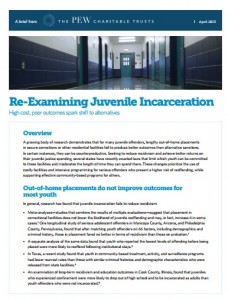 A growing body of research demonstrates that for many juvenile offenders, lengthy out-of-home placements in secure corrections or other residential facilities fail to produce better outcomes than alternative sanctions. In certain instances, they can be counterproductive. Seeking to reduce recidivism and achieve better returns on their juvenile justice spending, several states have recently enacted laws that limit which youth can be committed to these facilities and moderates the length of time they can spend there. These changes prioritize the use of costly facilities and intensive programming for serious offenders who present a higher risk of reoffending, while supporting effective community-based programs for others. This Pew – Public Safety Performance Project April 2015 report delves into how high costs and poor outcomes are sparking a shift toward criminal justice alternatives.
A growing body of research demonstrates that for many juvenile offenders, lengthy out-of-home placements in secure corrections or other residential facilities fail to produce better outcomes than alternative sanctions. In certain instances, they can be counterproductive. Seeking to reduce recidivism and achieve better returns on their juvenile justice spending, several states have recently enacted laws that limit which youth can be committed to these facilities and moderates the length of time they can spend there. These changes prioritize the use of costly facilities and intensive programming for serious offenders who present a higher risk of reoffending, while supporting effective community-based programs for others. This Pew – Public Safety Performance Project April 2015 report delves into how high costs and poor outcomes are sparking a shift toward criminal justice alternatives.